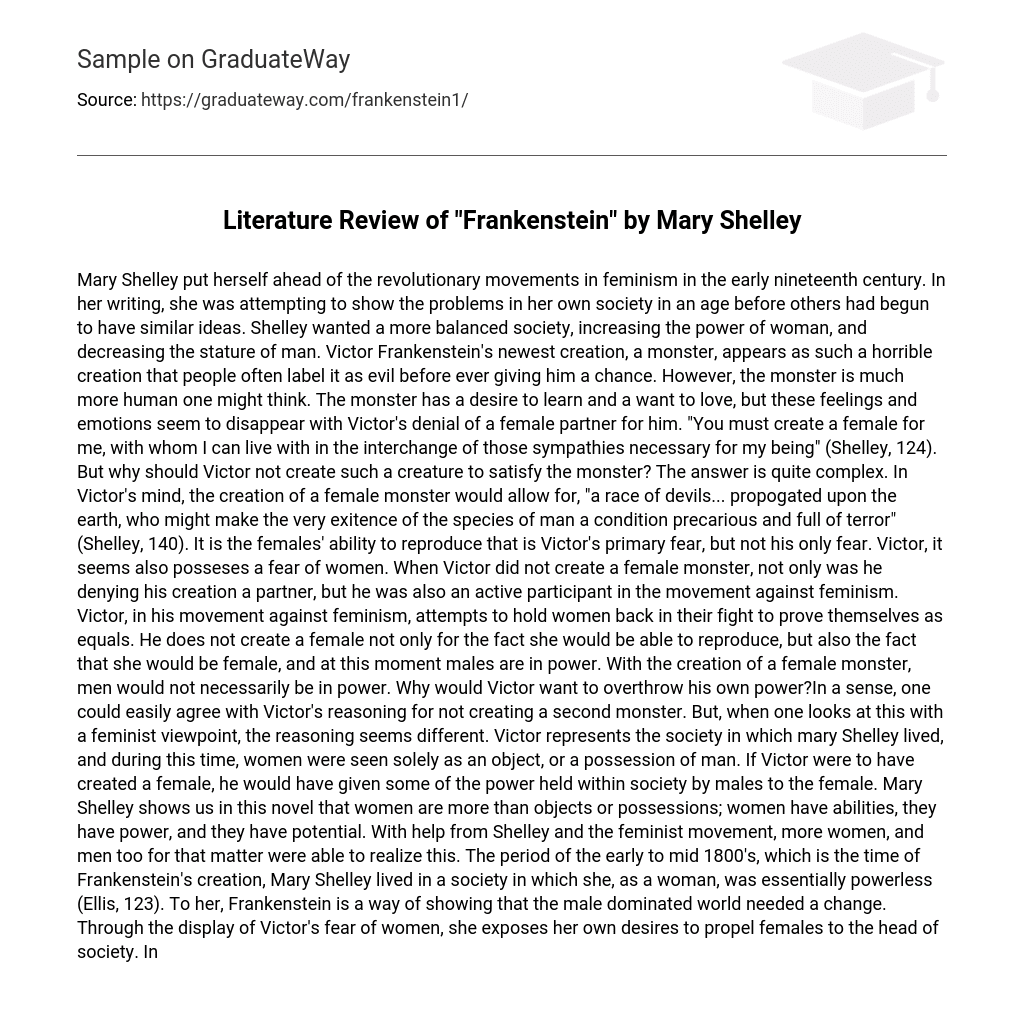Mary Shelley was a pioneer of feminist movements in the early 19th century, aiming to highlight societal issues before similar ideas emerged. Shelley desired a more equitable society, empowering women and reducing men’s dominance. Victor Frankenstein’s creation, commonly regarded as evil without a fair chance, is depicted as a frightful being. However, the monster possesses surprising humanity, with a thirst for knowledge and a longing for love. These emotions fade when Victor refuses to provide a female partner: “You must create a female for me, with whom I can live in the exchange of crucial sympathies for my existence.”
Nevertheless, there is a complex reason why Victor hesitates to fulfill the monster’s request for a female companion. Creating such a creature would result in “a race of devils… propogated upon the earth, who might make the very exitence of the species of man a condition precarious and full of terror,” according to Victor’s thoughts. The prospect of female monsters reproducing is Victor’s primary fear, but it is not his only fear. Evidently, Victor also harbors a fear of women. By refusing to create a female monster, Victor not only deprives his creation of a partner but also actively opposes feminism. In his resistance to feminism, Victor seeks to hinder women in their quest for equality. He refrains from creating a female not only because she would be capable of reproduction, but also because she would be female, and currently, males hold power.
The decision to create a female monster challenges the concept of male dominance and power. Although Victor’s desire to overthrow his own power may seem confusing, it becomes clearer when seen through a feminist lens. Victor embodies the societal norms of Mary Shelley’s time, where women were seen as mere objects or possessions of men. By creating a female creature, Victor would have transferred some of the power that men held in society to women. Through her novel, Mary Shelley presents women as more than just objects or possessions; they possess abilities, power, and potential. Thanks to Shelley and the feminist movement, both women and men have come to realize this truth.
Mary Shelley wrote Frankenstein during the early to mid 1800s, a time when women had limited power in society. Through this novel, she aims to draw attention to the need for change in a male-dominated world. Shelley’s own desire to advance women’s status is evident as she portrays Victor’s fear of women. Throughout the book, she also depicts her own repression in various scenes, such as the absence of any female character speaking. Instead, all speaking roles are given to males, further suppressing the female presence. Moreover, the novel emphasizes how women have limited involvement and are primarily seen as wives or lovers whose main responsibility is satisfying their male counterparts.
Even though the monster desires a female companion for his satisfaction, he never considers or cares that she may not reciprocate his feelings. This situation reflects the society in which Shelley lived. According to feminist critics, Frankenstein is primarily a novel that explores the oppression of women, with the monster symbolizing a marginalized figure who can never attain equality, regardless of his efforts. Despite playing a significant role in the story, the monster is never truly valued and encounters societal oppression, much like women. Neither the monster nor women pose a threat to society; they only seek love, happiness, and the respect they deserve. The only people who may perceive women as a threat are those against feminism. It is only after experiencing rejection, frustration, and loneliness that the monster becomes agitated and violent.
Shelley victimizes Justine in the courtroom, portraying her as a weak victim of accusation for a murder she did not commit. This not only includes being wrongfully accused but also being assumed guilty by her closest friends. These events further perpetuate the image of women as the “bad guys” and contribute to their oppression. It is noteworthy that Mary Shelley chooses to express her thoughts on feminism and the oppression of women through the voices of male characters in the book, namely Victor and his creation. Although this approach may be unconventional, Shelley effectively conveys her message.
Shelley, along with other feminists, was a pioneer in the feminist movement and has made important contributions to women’s rights over the last two centuries. Even though significant progress has been made towards achieving gender equality, instances of workplace discrimination such as unequal pay for equal work still persist. As we enter the new millennium, there is hope that men and women can transcend past conflicts in the gender battle and be treated equally without any exceptions. Once this objective is achieved, Shelley’s vision will have been realized.
References
- Shelley, Mary. Frankenstein, (1992) Clays Ltd, EnglandEllis, Kate.
- Monsters in the garden: Mary Shelley and the Bourgeois family, (1982) University of California Berkeley Press (123-142)





